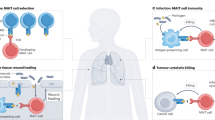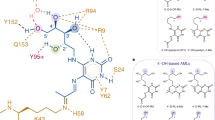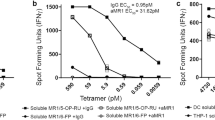Abstract
The antigen-presenting molecule MR1 presents vitamin B–related antigens (VitB antigens) to mucosal-associated invariant T (MAIT) cells through an uncharacterized pathway. We show that MR1, unlike other antigen-presenting molecules, does not constitutively present self-ligands. In the steady state it accumulates in a ligand-receptive conformation within the endoplasmic reticulum. VitB antigens reach this location and form a Schiff base with MR1, triggering a 'molecular switch' that allows MR1-VitB antigen complexes to traffic to the plasma membrane. These complexes are endocytosed with kinetics independent of the affinity of the MR1-ligand interaction and are degraded intracellularly, although some MR1 molecules acquire new ligands during passage through endosomes and recycle back to the surface. MR1 antigen presentation is characterized by a rapid 'off-on-off' mechanism that is strictly dependent on antigen availability.
This is a preview of subscription content, access via your institution
Access options
Subscribe to this journal
Receive 12 print issues and online access
$209.00 per year
only $17.42 per issue
Buy this article
- Purchase on Springer Link
- Instant access to full article PDF
Prices may be subject to local taxes which are calculated during checkout





Similar content being viewed by others
References
Rossjohn, J. et al. T cell antigen receptor recognition of antigen-presenting molecules. Annu. Rev. Immunol. 33, 169–200 (2015).
Pamer, E. & Cresswell, P. Mechanisms of MHC class I–restricted antigen processing. Annu. Rev. Immunol. 16, 323–358 (1998).
Heemels, M.T. & Ploegh, H. Generation, translocation, and presentation of MHC class I–restricted peptides. Annu. Rev. Biochem. 64, 463–491 (1995).
Villadangos, J.A. Presentation of antigens by MHC class II molecules: getting the most out of them. Mol. Immunol. 38, 329–346 (2001).
Barral, D.C. & Brenner, M.B. CD1 antigen presentation: how it works. Nat. Rev. Immunol. 7, 929–941 (2007).
Corbett, A.J. et al. T-cell activation by transitory neo-antigens derived from distinct microbial pathways. Nature 509, 361–365 (2014).
Kjer-Nielsen, L. et al. MR1 presents microbial vitamin B metabolites to MAIT cells. Nature 491, 717–723 (2012).
McWilliam, H.E., Birkinshaw, R.W., Villadangos, J.A., McCluskey, J. & Rossjohn, J. MR1 presentation of vitamin B–based metabolite ligands. Curr. Opin. Immunol. 34, 28–34 (2015).
Eckle, S.B. et al. Recognition of vitamin B precursors and byproducts by mucosal associated invariant T cells. J. Biol. Chem. 290, 30204–30211 (2015).
Eckle, S.B. et al. A molecular basis underpinning the T cell receptor heterogeneity of mucosal-associated invariant T cells. J. Exp. Med. 211, 1585–1600 (2014).
Reantragoon, R. et al. Structural insight into MR1-mediated recognition of the mucosal associated invariant T cell receptor. J. Exp. Med. 209, 761–774 (2012).
Patel, O. et al. Recognition of vitamin B metabolites by mucosal-associated invariant T cells. Nat. Commun. 4, 2142 (2013).
Gapin, L. Check MAIT. J. Immunol. 192, 4475–4480 (2014).
Gold, M.C. & Lewinsohn, D.M. Co-dependents: MR1-restricted MAIT cells and their antimicrobial function. Nat. Rev. Microbiol. 11, 14–19 (2013).
Sakala, I.G. et al. Functional heterogeneity and antimycobacterial effects of mouse mucosal-associated invariant T cells specific for riboflavin metabolites. J. Immunol. 195, 587–601 (2015).
Soudais, C. et al. In vitro and in vivo analysis of the Gram-negative bacteria–derived riboflavin precursor derivatives activating mouse MAIT cells. J. Immunol. 194, 4641–4649 (2015).
Gold, M.C. et al. Human mucosal associated invariant T cells detect bacterially infected cells. PLoS Biol. 8, e1000407 (2010).
Le Bourhis, L. et al. Antimicrobial activity of mucosal-associated invariant T cells. Nat. Immunol. 11, 701–708 (2010).
Huang, S. et al. MR1 uses an endocytic pathway to activate mucosal-associated invariant T cells. J. Exp. Med. 205, 1201–1211 (2008).
Ahner, A. & Brodsky, J.L. Checkpoints in ER-associated degradation: excuse me, which way to the proteasome? Trends Cell Biol. 14, 474–478 (2004).
Chua, W.J. et al. Endogenous MHC-related protein 1 is transiently expressed on the plasma membrane in a conformation that activates mucosal-associated invariant T cells. J. Immunol. 186, 4744–4750 (2011).
Reantragoon, R. et al. Antigen-loaded MR1 tetramers define T cell receptor heterogeneity in mucosal-associated invariant T cells. J. Exp. Med. 210, 2305–2320 (2013).
Morris, A.J., Davenport, R.C. & Tolan, D.R. A lysine to arginine substitution at position 146 of rabbit aldolase A changes the rate-determining step to Schiff base formation. Protein Eng. 9, 61–67 (1996).
Liu, H. & Johnston, A.P.R. A programmable sensor to probe the internalization of proteins and nanoparticles in live cells. Angew. Chem. Int. Ed. 52, 5744–5748 (2013).
Reuter, A. et al. Criteria for dendritic cell receptor selection for efficient antibody-targeted vaccination. J. Immunol. 194, 2696–2705 (2015).
Neefjes, J., Jongsma, M.L., Paul, P. & Bakke, O. Towards a systems understanding of MHC class I and MHC class II antigen presentation. Nat. Rev. Immunol. 11, 823–836 (2011).
Godfrey, D.I., Uldrich, A.P., McCluskey, J., Rossjohn, J. & Moody, D.B. The burgeoning family of unconventional T cells. Nat. Immunol. 16, 1114–1123 (2015).
Van Rhijn, I., Godfrey, D.I., Rossjohn, J. & Moody, D.B. Lipid and small-molecule display by CD1 and MR1. Nat. Rev. Immunol. 15, 643–654 (2015).
Holst, J. et al. Generation of T-cell receptor retrogenic mice. Nat. Protoc. 1, 406–417 (2006).
Huang, S. et al. Evidence for MR1 antigen presentation to mucosal-associated invariant T cells. J. Biol. Chem. 280, 21183–21193 (2005).
Tilloy, F. et al. An invariant T cell receptor α−chain defines a novel TAP-independent major histocompatibility complex class Ib–restricted α/β T cell subpopulation in mammals. J. Exp. Med. 189, 1907–1921 (1999).
Hoiseth, S.K. & Stocker, B.A. Aromatic-dependent Salmonella typhimurium are non-virulent and effective as live vaccines. Nature 291, 238–239 (1981).
Datsenko, K.A. & Wanner, B.L. One-step inactivation of chromosomal genes in Escherichia coli K-12 using PCR products. Proc. Natl. Acad. Sci. USA 97, 6640–6645 (2000).
Strugnell, R. et al. Characterization of a Salmonella typhimurium aro vaccine strain expressing the P.69 antigen of Bordetella pertussis. Infect. Immun. 60, 3994–4002 (1992).
Reuter, A. et al. Criteria for dendritic cell receptor selection for efficient antibody-targeted vaccination. J. Immunol. 194, 2696–2705 (2015).
Acknowledgements
We thank T. Hansen (University of Washington) and W.J. Yankelevich (US Food and Drug Administration) for the gift of the 8F2.F9 hybridoma; L. Knodler (Washington State University College) for mCherry reagents; C. Dumont (University of Melbourne) for assistance with the internalization and recycling assays; H. Reid (Monash University) for assistance in cloning the MR1 K43R mutant; S. Londrigan (University of Melbourne) for assistance with the bronchial epithelial cells; and the Biological Optical Microscopy Platform (University of Melbourne) for microscopy expertise. S.B.G.E. is supported by an Early Career Research award from The University of Melbourne. This research was supported by the Australian National Health and Medical Research Council (NHMRC) (D.P.F., R.A.S., J.M., J.R. and J.A.V.) and the Australian Research Council (D.P.F. and J.R.).
Author information
Authors and Affiliations
Contributions
H.E.G.M. undertook experiments, analyzed data and provided intellectual input. S.B.G.E., A.T., L.L., Z.C., J.M.W., D.P.F., R.A.S. and J.D.M. performed experiments, provided key reagents, analyzed data and/or provided intellectual input. J.M., J.R. and J.A.V. led the investigation and devised the project. H.E.G.M., J.R. and J.A.V. wrote the manuscript.
Corresponding authors
Ethics declarations
Competing interests
The authors declare no competing financial interests.
Integrated supplementary information
Supplementary Figure 1 Production of the MAIT TCR tetramer
SDS-PAGE of E. coli-expressed TCR α- and β-chains of the MAIT TCR (upper panel). Non-reducing peak fraction lane 1, all fractions reducing lanes 3-8, including as a control 2 μg of reduced previously-generated irrelevant TCR (lane 2). SDS-PAGE of biotinylated and multimerised MAIT TCR (middle panel). Streptavidin alone (lane 1), TCR alone (lane 2), biotinylated TCR (lane 3) and multimerised TCR (lane 4). MonoQ anion exchange chromatography was used to purify biotinylated TCR (lower panel).
Supplementary Figure 2 MR1 and MHC class I surface expression kinetics in C1R.MR1 cells
MR1 cell surface expression (a) in C1R.MR1 cells over time measured with mAb 26.5 by flow cytometry, with MHC class I expression for comparison (b), and represented as geometric mean fluorescence intensity (gMFI) +/- standard error of the mean (s.e.m.). Cells were incubated with no ligand (upper graph) or with 10 μM Ac-6-FP (middle) or 5-OP-RU (lower), in the presence of brefeldin A, cycloheximide or without inhibitors.
Supplementary Figure 3 MR1-GFP remains immature until ligands promote maturation, similar to wild-type MR1
Analysis of Endo H-treated (+) or untreated (–) MR1-GFP precipitated from C1R cells transduced with MR1-GFP and cultured with or without 100 μM Ac-6-FP or 5-OP-RU for 6 hours. MR1-GFP was immunoprecipitated using anti-GFP agarose beads (GFP-Trap, Chromotek), and immunoblotted for GFP or β2m.
Supplementary Figure 4 MR1 trafficking schematic
In the steady state, MR1 predominantly resides as an immature protein in the endoplasmic reticulum (ER) in an unfolded conformation (1). Metabolite ligands derived from the extracellular medium or intracellular bacteria enter the ER via an unknown mechanism and load onto immature MR1 (2), where the charged lys43 (+) is neutralized and conformational folding occurs, including strong β2m association. Traffic through the Golgi apparatus results in further glycosylation (3). Mature MR1 remains at the cell surface for several hours (4) and is internalized to the endosomal compartment (5), with a low level of recycling back to the surface. MR1 may be degraded from the endosomes or directly from the ER (6).
Supplementary information
Supplementary Text and Figures
Supplementary Figures 1–4 (PDF 1204 kb)
Rights and permissions
About this article
Cite this article
McWilliam, H., Eckle, S., Theodossis, A. et al. The intracellular pathway for the presentation of vitamin B–related antigens by the antigen-presenting molecule MR1. Nat Immunol 17, 531–537 (2016). https://doi.org/10.1038/ni.3416
Received:
Accepted:
Published:
Issue Date:
DOI: https://doi.org/10.1038/ni.3416
This article is cited by
-
Delivery of loaded MR1 monomer results in efficient ligand exchange to host MR1 and subsequent MR1T cell activation
Communications Biology (2024)
-
TAPBPR employs a ligand-independent docking mechanism to chaperone MR1 molecules
Nature Chemical Biology (2022)
-
Alternative splicing of MR1 regulates antigen presentation to MAIT cells
Scientific Reports (2020)
-
Rab6 regulates recycling and retrograde trafficking of MR1 molecules
Scientific Reports (2020)
-
Genome-wide CRISPR–Cas9 screening reveals ubiquitous T cell cancer targeting via the monomorphic MHC class I-related protein MR1
Nature Immunology (2020)



